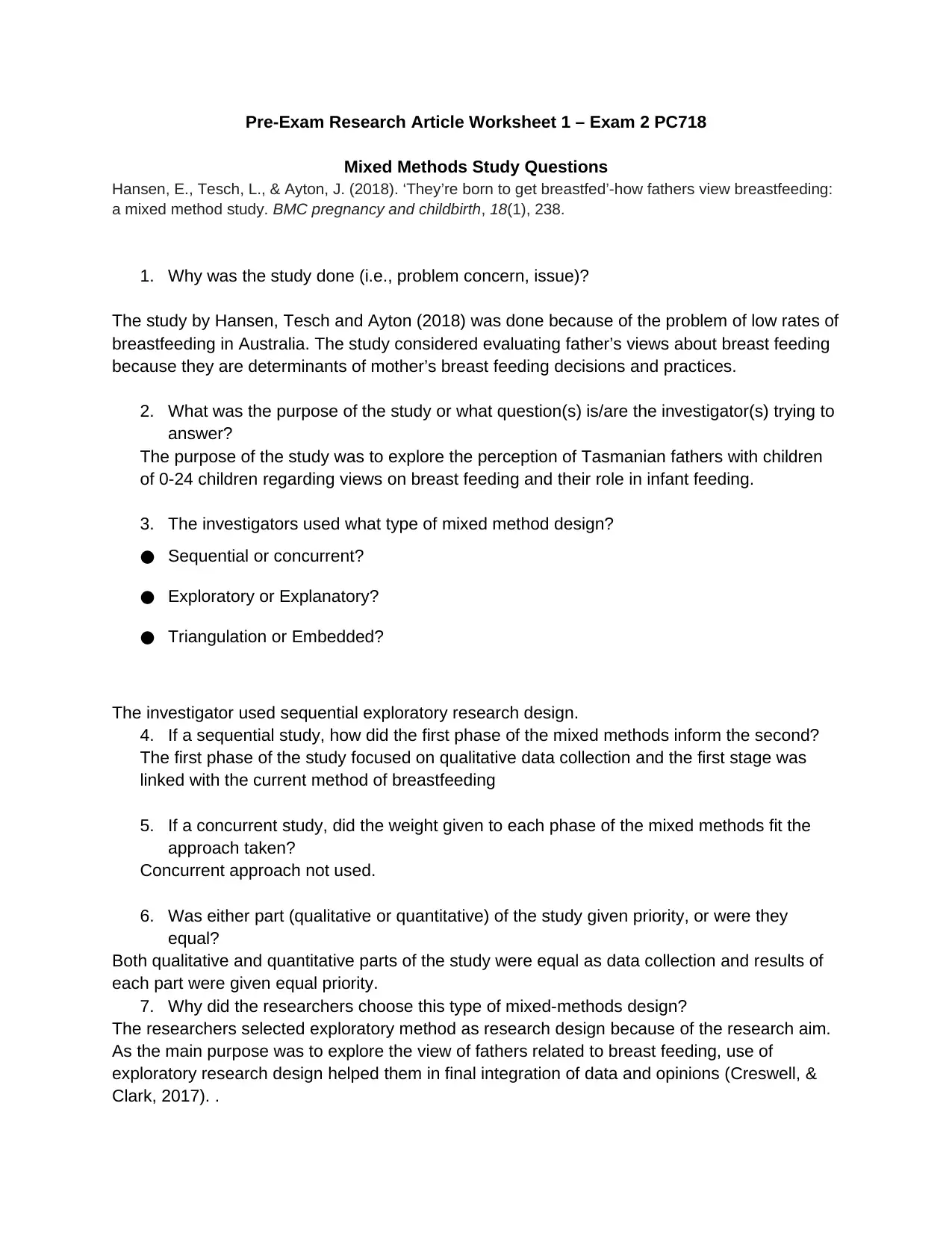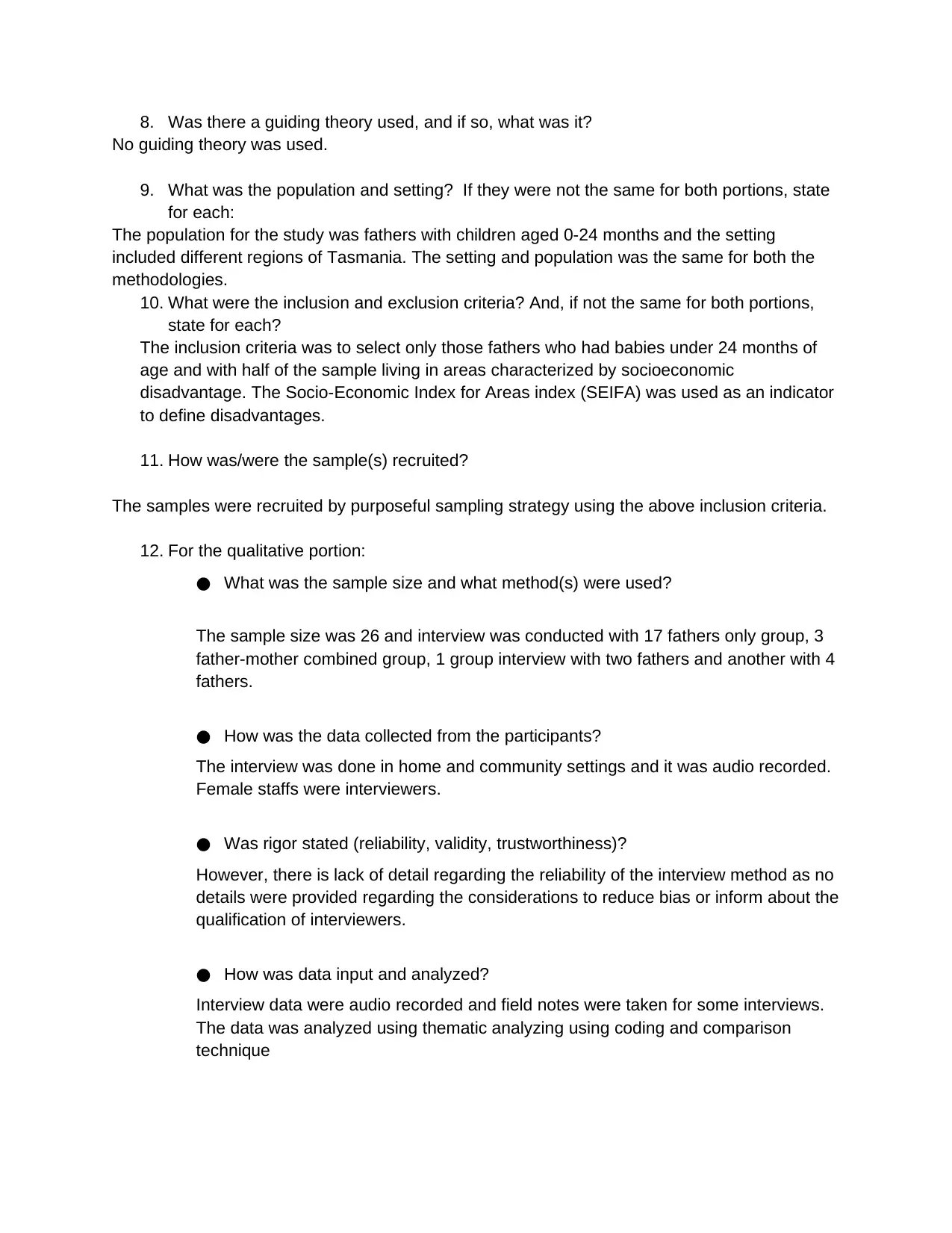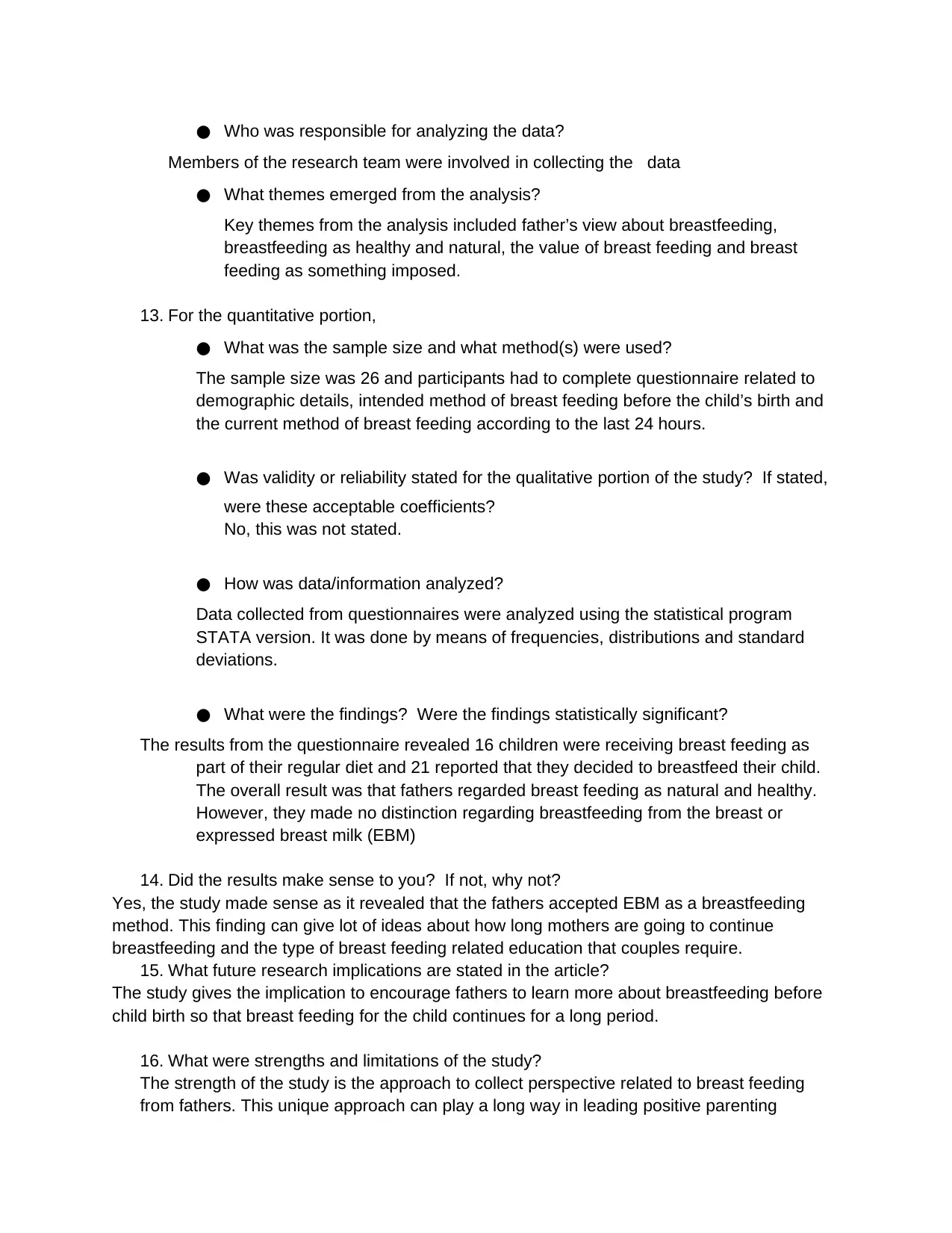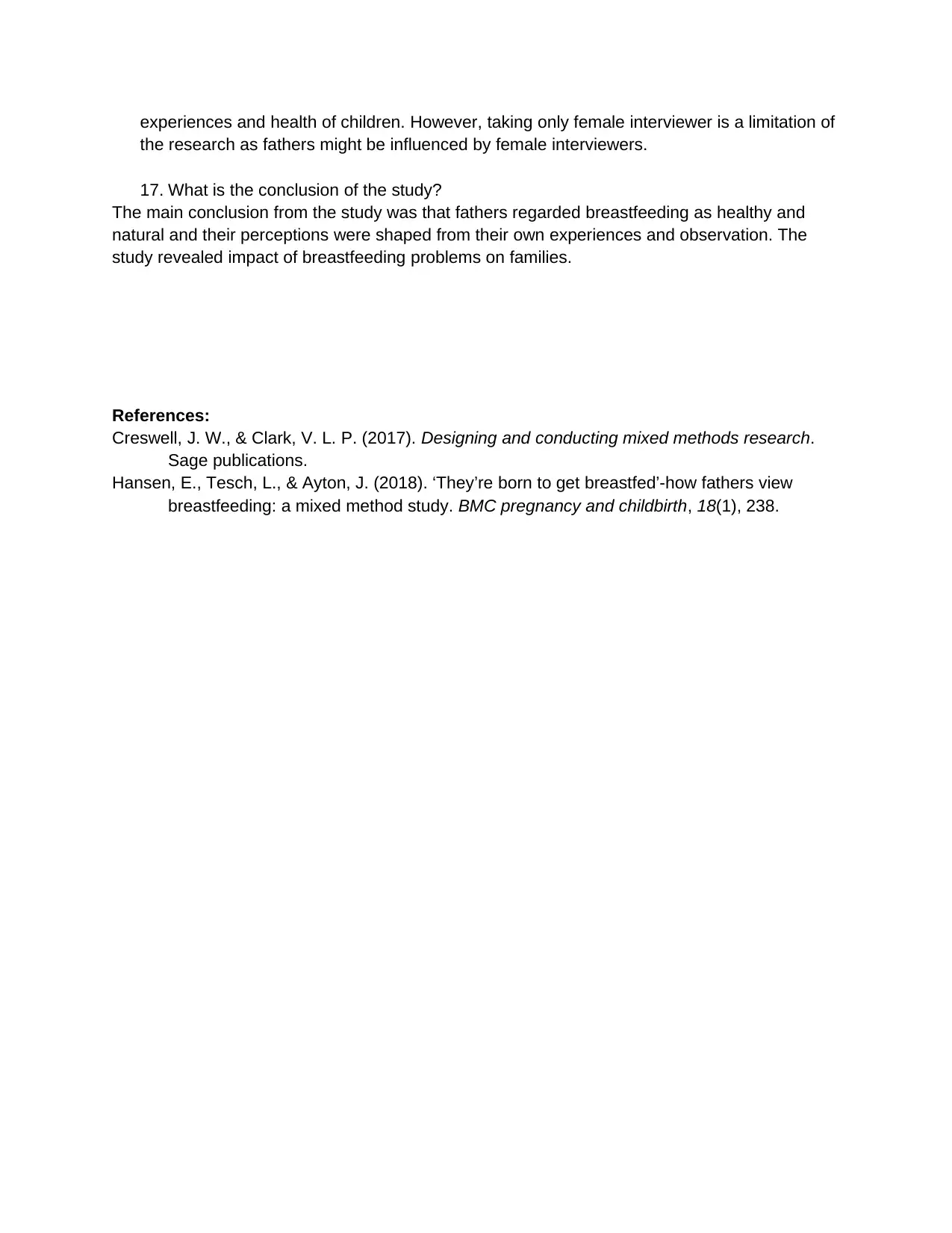PC718 Exam 2: Analysis of a Mixed Methods Research Article Worksheet
VerifiedAdded on 2022/09/17
|4
|1242
|21
Homework Assignment
AI Summary
This assignment is a worksheet analyzing the mixed methods study by Hansen, Tesch, and Ayton (2018) on fathers' views on breastfeeding. The study investigated the perceptions of Tasmanian fathers regarding breastfeeding and their role in infant feeding, driven by low breastfeeding rates in Australia. The researchers employed a sequential exploratory design, integrating qualitative interviews with 26 fathers and quantitative questionnaires. The qualitative data, collected through interviews, revealed key themes such as fathers' views on breastfeeding as healthy and natural. The quantitative data, analyzed using statistical methods, supported the view of fathers regarding breastfeeding. The study's strengths include its unique approach to gathering fathers' perspectives, while a limitation is the exclusive use of female interviewers. The conclusion highlights that fathers view breastfeeding as healthy and natural, shaped by their experiences, which can impact breastfeeding practices and education for couples. The study offers implications for promoting breastfeeding through education for fathers.

Pre-Exam Research Article Worksheet 1 – Exam 2 PC718
Mixed Methods Study Questions
Hansen, E., Tesch, L., & Ayton, J. (2018). ‘They’re born to get breastfed’-how fathers view breastfeeding:
a mixed method study. BMC pregnancy and childbirth, 18(1), 238.
1. Why was the study done (i.e., problem concern, issue)?
The study by Hansen, Tesch and Ayton (2018) was done because of the problem of low rates of
breastfeeding in Australia. The study considered evaluating father’s views about breast feeding
because they are determinants of mother’s breast feeding decisions and practices.
2. What was the purpose of the study or what question(s) is/are the investigator(s) trying to
answer?
The purpose of the study was to explore the perception of Tasmanian fathers with children
of 0-24 children regarding views on breast feeding and their role in infant feeding.
3. The investigators used what type of mixed method design?
● Sequential or concurrent?
● Exploratory or Explanatory?
● Triangulation or Embedded?
The investigator used sequential exploratory research design.
4. If a sequential study, how did the first phase of the mixed methods inform the second?
The first phase of the study focused on qualitative data collection and the first stage was
linked with the current method of breastfeeding
5. If a concurrent study, did the weight given to each phase of the mixed methods fit the
approach taken?
Concurrent approach not used.
6. Was either part (qualitative or quantitative) of the study given priority, or were they
equal?
Both qualitative and quantitative parts of the study were equal as data collection and results of
each part were given equal priority.
7. Why did the researchers choose this type of mixed-methods design?
The researchers selected exploratory method as research design because of the research aim.
As the main purpose was to explore the view of fathers related to breast feeding, use of
exploratory research design helped them in final integration of data and opinions (Creswell, &
Clark, 2017). .
Mixed Methods Study Questions
Hansen, E., Tesch, L., & Ayton, J. (2018). ‘They’re born to get breastfed’-how fathers view breastfeeding:
a mixed method study. BMC pregnancy and childbirth, 18(1), 238.
1. Why was the study done (i.e., problem concern, issue)?
The study by Hansen, Tesch and Ayton (2018) was done because of the problem of low rates of
breastfeeding in Australia. The study considered evaluating father’s views about breast feeding
because they are determinants of mother’s breast feeding decisions and practices.
2. What was the purpose of the study or what question(s) is/are the investigator(s) trying to
answer?
The purpose of the study was to explore the perception of Tasmanian fathers with children
of 0-24 children regarding views on breast feeding and their role in infant feeding.
3. The investigators used what type of mixed method design?
● Sequential or concurrent?
● Exploratory or Explanatory?
● Triangulation or Embedded?
The investigator used sequential exploratory research design.
4. If a sequential study, how did the first phase of the mixed methods inform the second?
The first phase of the study focused on qualitative data collection and the first stage was
linked with the current method of breastfeeding
5. If a concurrent study, did the weight given to each phase of the mixed methods fit the
approach taken?
Concurrent approach not used.
6. Was either part (qualitative or quantitative) of the study given priority, or were they
equal?
Both qualitative and quantitative parts of the study were equal as data collection and results of
each part were given equal priority.
7. Why did the researchers choose this type of mixed-methods design?
The researchers selected exploratory method as research design because of the research aim.
As the main purpose was to explore the view of fathers related to breast feeding, use of
exploratory research design helped them in final integration of data and opinions (Creswell, &
Clark, 2017). .
Paraphrase This Document
Need a fresh take? Get an instant paraphrase of this document with our AI Paraphraser

8. Was there a guiding theory used, and if so, what was it?
No guiding theory was used.
9. What was the population and setting? If they were not the same for both portions, state
for each:
The population for the study was fathers with children aged 0-24 months and the setting
included different regions of Tasmania. The setting and population was the same for both the
methodologies.
10. What were the inclusion and exclusion criteria? And, if not the same for both portions,
state for each?
The inclusion criteria was to select only those fathers who had babies under 24 months of
age and with half of the sample living in areas characterized by socioeconomic
disadvantage. The Socio-Economic Index for Areas index (SEIFA) was used as an indicator
to define disadvantages.
11. How was/were the sample(s) recruited?
The samples were recruited by purposeful sampling strategy using the above inclusion criteria.
12. For the qualitative portion:
● What was the sample size and what method(s) were used?
The sample size was 26 and interview was conducted with 17 fathers only group, 3
father-mother combined group, 1 group interview with two fathers and another with 4
fathers.
● How was the data collected from the participants?
The interview was done in home and community settings and it was audio recorded.
Female staffs were interviewers.
● Was rigor stated (reliability, validity, trustworthiness)?
However, there is lack of detail regarding the reliability of the interview method as no
details were provided regarding the considerations to reduce bias or inform about the
qualification of interviewers.
● How was data input and analyzed?
Interview data were audio recorded and field notes were taken for some interviews.
The data was analyzed using thematic analyzing using coding and comparison
technique
No guiding theory was used.
9. What was the population and setting? If they were not the same for both portions, state
for each:
The population for the study was fathers with children aged 0-24 months and the setting
included different regions of Tasmania. The setting and population was the same for both the
methodologies.
10. What were the inclusion and exclusion criteria? And, if not the same for both portions,
state for each?
The inclusion criteria was to select only those fathers who had babies under 24 months of
age and with half of the sample living in areas characterized by socioeconomic
disadvantage. The Socio-Economic Index for Areas index (SEIFA) was used as an indicator
to define disadvantages.
11. How was/were the sample(s) recruited?
The samples were recruited by purposeful sampling strategy using the above inclusion criteria.
12. For the qualitative portion:
● What was the sample size and what method(s) were used?
The sample size was 26 and interview was conducted with 17 fathers only group, 3
father-mother combined group, 1 group interview with two fathers and another with 4
fathers.
● How was the data collected from the participants?
The interview was done in home and community settings and it was audio recorded.
Female staffs were interviewers.
● Was rigor stated (reliability, validity, trustworthiness)?
However, there is lack of detail regarding the reliability of the interview method as no
details were provided regarding the considerations to reduce bias or inform about the
qualification of interviewers.
● How was data input and analyzed?
Interview data were audio recorded and field notes were taken for some interviews.
The data was analyzed using thematic analyzing using coding and comparison
technique

● Who was responsible for analyzing the data?
Members of the research team were involved in collecting the data
● What themes emerged from the analysis?
Key themes from the analysis included father’s view about breastfeeding,
breastfeeding as healthy and natural, the value of breast feeding and breast
feeding as something imposed.
13. For the quantitative portion,
● What was the sample size and what method(s) were used?
The sample size was 26 and participants had to complete questionnaire related to
demographic details, intended method of breast feeding before the child’s birth and
the current method of breast feeding according to the last 24 hours.
● Was validity or reliability stated for the qualitative portion of the study? If stated,
were these acceptable coefficients?
No, this was not stated.
● How was data/information analyzed?
Data collected from questionnaires were analyzed using the statistical program
STATA version. It was done by means of frequencies, distributions and standard
deviations.
● What were the findings? Were the findings statistically significant?
The results from the questionnaire revealed 16 children were receiving breast feeding as
part of their regular diet and 21 reported that they decided to breastfeed their child.
The overall result was that fathers regarded breast feeding as natural and healthy.
However, they made no distinction regarding breastfeeding from the breast or
expressed breast milk (EBM)
14. Did the results make sense to you? If not, why not?
Yes, the study made sense as it revealed that the fathers accepted EBM as a breastfeeding
method. This finding can give lot of ideas about how long mothers are going to continue
breastfeeding and the type of breast feeding related education that couples require.
15. What future research implications are stated in the article?
The study gives the implication to encourage fathers to learn more about breastfeeding before
child birth so that breast feeding for the child continues for a long period.
16. What were strengths and limitations of the study?
The strength of the study is the approach to collect perspective related to breast feeding
from fathers. This unique approach can play a long way in leading positive parenting
Members of the research team were involved in collecting the data
● What themes emerged from the analysis?
Key themes from the analysis included father’s view about breastfeeding,
breastfeeding as healthy and natural, the value of breast feeding and breast
feeding as something imposed.
13. For the quantitative portion,
● What was the sample size and what method(s) were used?
The sample size was 26 and participants had to complete questionnaire related to
demographic details, intended method of breast feeding before the child’s birth and
the current method of breast feeding according to the last 24 hours.
● Was validity or reliability stated for the qualitative portion of the study? If stated,
were these acceptable coefficients?
No, this was not stated.
● How was data/information analyzed?
Data collected from questionnaires were analyzed using the statistical program
STATA version. It was done by means of frequencies, distributions and standard
deviations.
● What were the findings? Were the findings statistically significant?
The results from the questionnaire revealed 16 children were receiving breast feeding as
part of their regular diet and 21 reported that they decided to breastfeed their child.
The overall result was that fathers regarded breast feeding as natural and healthy.
However, they made no distinction regarding breastfeeding from the breast or
expressed breast milk (EBM)
14. Did the results make sense to you? If not, why not?
Yes, the study made sense as it revealed that the fathers accepted EBM as a breastfeeding
method. This finding can give lot of ideas about how long mothers are going to continue
breastfeeding and the type of breast feeding related education that couples require.
15. What future research implications are stated in the article?
The study gives the implication to encourage fathers to learn more about breastfeeding before
child birth so that breast feeding for the child continues for a long period.
16. What were strengths and limitations of the study?
The strength of the study is the approach to collect perspective related to breast feeding
from fathers. This unique approach can play a long way in leading positive parenting
⊘ This is a preview!⊘
Do you want full access?
Subscribe today to unlock all pages.

Trusted by 1+ million students worldwide

experiences and health of children. However, taking only female interviewer is a limitation of
the research as fathers might be influenced by female interviewers.
17. What is the conclusion of the study?
The main conclusion from the study was that fathers regarded breastfeeding as healthy and
natural and their perceptions were shaped from their own experiences and observation. The
study revealed impact of breastfeeding problems on families.
References:
Creswell, J. W., & Clark, V. L. P. (2017). Designing and conducting mixed methods research.
Sage publications.
Hansen, E., Tesch, L., & Ayton, J. (2018). ‘They’re born to get breastfed’-how fathers view
breastfeeding: a mixed method study. BMC pregnancy and childbirth, 18(1), 238.
the research as fathers might be influenced by female interviewers.
17. What is the conclusion of the study?
The main conclusion from the study was that fathers regarded breastfeeding as healthy and
natural and their perceptions were shaped from their own experiences and observation. The
study revealed impact of breastfeeding problems on families.
References:
Creswell, J. W., & Clark, V. L. P. (2017). Designing and conducting mixed methods research.
Sage publications.
Hansen, E., Tesch, L., & Ayton, J. (2018). ‘They’re born to get breastfed’-how fathers view
breastfeeding: a mixed method study. BMC pregnancy and childbirth, 18(1), 238.
1 out of 4
Related Documents
Your All-in-One AI-Powered Toolkit for Academic Success.
+13062052269
info@desklib.com
Available 24*7 on WhatsApp / Email
![[object Object]](/_next/static/media/star-bottom.7253800d.svg)
Unlock your academic potential
Copyright © 2020–2025 A2Z Services. All Rights Reserved. Developed and managed by ZUCOL.





